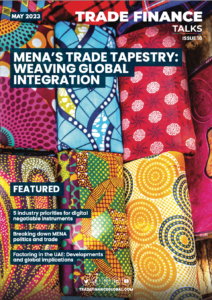Diligently categorising the content of 4 billion sheets of paper – enough to form a stack over 400 kilometres tall – is no small task, but that’s just the task that the International Chamber of Commerce (ICC) Digital Standards Initiative’s (DSI) Key Trade Document and Data Elements (KTDDE) Working Group has done.
These 4 billion sheets of paper represent all international trade documents, from certificates of origin to commercial invoices, in circulation at any time.
In an effort to drive trade digitalisation by promoting the interoperability of digital documents, the DSI’s KTDDE has released its systematic digital standards analysis.
The 52-page ICC DSI report identifies and defines the key data elements held within each of the seven identified key trade documents:
- Certificate of origin
- Customs declaration
- Packing list
- Bill of lading
- Commercial invoice
- Warehouse receipt
- Insurance certificate
The resulting dataset provides guidance on how common data approaches and digital standards could facilitate seamless data sharing across digital applications, reducing the need for wasteful and error-prone rekeying processes.
Pamela Mar, Managing Director of the Digital Standards Initiative (DSI) of the International Chamber of Commerce, told TFG, “It’s no secret that a key barrier to digitising trade and supply chain processes is the many different versions of the same documents – created by different buyers, supply chain players or digital networks.
As one moves across supply chains, there might be great similarities in the data that is being captured, but the formats and documentation are vastly different. The purpose of the Key Trade Documents and Data Elements Working Group was to collapse these different versions into datasets. This will help to reach an agreement, or at least alignment, across key industry working groups, which set documentation standards on the core data needed at each stage of the supply chain.
We sought to provide recommendations on how these data elements should be defined and exchanged. Now, we have identified the core data points needed to transact at each stage and a recommended glossary of terms.”
Key recommendations from the report
Accelerating digital trade adoption requires a collaborative, multifaceted approach from various interrelated industry stakeholders.
To achieve this end goal, the DSI’s KTDDE makes four fundamental recommendations in their report:
- Make systems and platforms compatible by design: Electronic data interchange systems must work with at least one major recognised standard and ideally with multiple standards.
- Align to best practice definitions of key data elements: Organisations issuing and accepting data, as well as relevant regulators, should align to best practice definitions to ensure interoperability.
- Use existing agreements to adapt to a changing environment: It is important for governments and regulators to explore ways to collaborate on new trade standards for emerging digital trade issues like smart contracts.
- Pursue a “digital by default” strategy: Organisations should adopt a 100% digital document issuing process, eliminating paper documents and wet stamps from the outset.
Analysis and key findings
The working group’s analysis examined the intended purpose and usage of each document, the applicable legal frameworks, existing key standards, and the current obstacles standing in the way of digitalisation.
This involved working closely with various industry stakeholders, including private, industry and public entities, with knowledge and experience in digitalising respective documents.
The analysis uncovered that while there are multiple existing standards with few material differences, a handful of differing data element definitions created difficulties for customs authorities in interpreting and processing some of the documents from abroad.
It also revealed noticeable gaps in standardisation, including a need for globally accepted standards for insurance certificates.
While significant progress has been made in developing international standards for these documents, interoperability challenges have created a lag in the uptake of digital trade documents.
Overcoming the challenges of the current digital trade landscape
The digital trade landscape is rapidly evolving, with ongoing efforts to harmonise and align trade processes and related key trade documents.
Multiple industries, including banking, freight forwarding, and shipping, have actively promoted common industry-wide standards around electronic documents such as the bill of lading.
The interoperability of supply chain data is often viewed as a prospective solution to address the long-standing challenge of trade finance faced by small- and medium-sized enterprises (SMEs).
The development of global standards for data sharing, transparency, and alignment of practices, however, is a complex task and remains a major challenge for advocates of digital trade.
Still, progress has been made through the emergence of digital trade and supply chain platforms, industry networks, and initiatives such as the ICC DSI that aim to align data and practices.
By identifying the key data elements used across documents and promoting best practices across markets, sectors, and national and international trade landscapes, this latest report has taken a step toward narrowing the discrepancy between the current digital trade landscape and its ideal future version.
Looking towards the future and next steps for ICC DSI, Mar said, “This is a first step at driving alignment across the industry on the data set needed to replace, and effect, the transactions that are currently processed with paper and PDF documentation. The next step is to encourage adoption of the core dataset amongst industry groups and supply chain platforms together with the protocols for exchange and data sharing.
There is a tremendous amount of overlap in the data elements needed at each stage of the supply chain. Today’s supply chains replicate data terms from one player to another, from one document to another. We want to encourage everyone to use technology to start sharing data in their original secured form across the supply chain. So we will be going out to engage industry groups, supply chain platforms, and even financial institutions to align their systems to these common standards.”










































